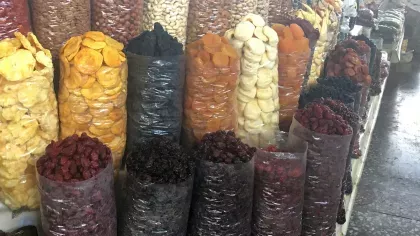Enhancing rural Caucasian livelihoods through fruit and nut conservation
Protecting important fruit and nut species in Georgia and Armenia through rural community engagements, ex situ seed conservation and research.

The Caucasus represents one of the most diverse and endangered hotpots in the world, with around 6,400 known plant species found in the region, of which, more than 25 per cent are endemic. The region also harbours a remarkable concentration of economically important plants. Some 2,000 species have direct economic value and are used for a wide variety of purposes ranging from timber and fire-wood, to food and forage as well as those used for medicine and dyes. Of these, over 260 species are wild-growing fruits, including wild berries which account for over 50 per cent of the total value of cash forest products collected.
Major contemporary threats to wild fruit and nut populations include illegal logging, fuel-wood harvesting, overgrazing and pollution. Indeed, unsustainable, illegal logging, often by large commercial operators for export, is rapidly driving wild species to extinction and it is now estimated that less than 12 per cent of the vegetation of the Caucasus remains unspoiled. The biodiversity of the Caucasus forms the foundation of rural livelihoods in the region and its loss would have a significant negative effect on humans, flora and fauna. Protection of important wild fruit and nut populations, some of which survived the ice-age, would provide the scientific community with access to unique traits of resistance and tolerance, as well as ensuring the continued income, medical resources and diverse diet for reliant, rural communities who harvest these wild species.
At Kew, we are working closely with collaborators in Georgia and Armenia to ensure the conservation of wild fruit and nut species through collecting and safe guarding seeds of over 120 wild fruit and nut species. The project will also address existing information gaps for 20 endemics, suspected endangered species which are of high economic importance to rural communities. Research conducted by partners into the taxonomic and genetic variation between populations, as well as the socio-economic place of the species in local communities will improve scientific understanding of the threats to, and uses of, those species. Finally, as rural communities still have strong intrinsic links with the landscape, close engagement with local communities will be key in understanding the patterns and use of wild fruit and nut species in Georgia and Armenia, as well as help support sustainable wild harvesting into the future.
Objectives
- Conservation seed collections of 122 important fruit and nut species from Georgia and Armenia, stored in-country and duplicated to the MSB in the UK.
- Training of partner staff in seed conservation and red-listing, and capacity building of their organisations.
- Research into genetic diversity and uses of species completed by MSc students and partner staff.
- Extinction risk assessments of 20 of the target species conducted by partners, after training from Kew’s Plant Assessment Unit, and published through the IUCN.
- Community engagement for the purposes of ethnobotanical learning and community education delivered by partners in collaboration with regional social scientists. Learning gained from project research and red-list assessments will be shared with community members, including actions they can take to protect relevant taxa and improve their standards of living. Targeted coaching with 'biodiversity champions' in each community will promote the dissemination of learning and information sharing techniques amongst other communities beyond the project end.
Georgia
- National Botanical Garden, Georgia (NBGG)
- Institute of Botany, Georgia (IoB)
Armenia
- Nature Heritage, Armenia (NH)
